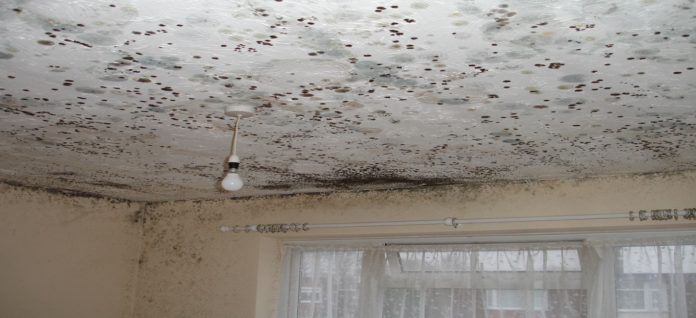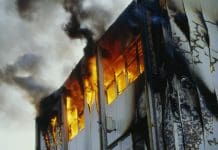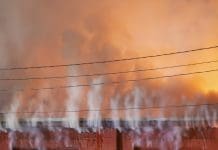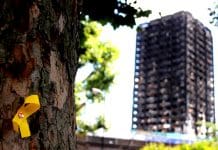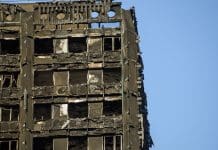Good ventilation is essential in controlling damp, mould and pollutants but a lack of compliance with Building Regulations in this area is widespread. When we’re not getting it right with new builds, what hope is there for proper ventilation in existing buildings, asks James Berry of the Property Care Association
We are now three years on from the tragic events of the Grenfell Tower fire. It was clear at the time that lessons needed to be learned to prevent such devastating circumstances ever happening again. Are we learning these lessons and are we doing it fast enough? Well, the evidence is suggesting that we are not.
Recently, the National Audit Office (NAO) reported that the government has fallen behind its own targets for the removal of aluminium composite material (ACM) from high-rise buildings. We know now that the cladding installed at Grenfell did not comply with Approved Document B. Now this might seem like an odd place to start on an article about ventilation in existing buildings but in her subsequent report, Dame Judith Hackitt says that the current approved documents “can be ambiguous and inconsistent”. Lack of compliance with Approved Document F, Means of Ventilation, is almost endemic.
The objective of Approved Document F is to ensure there is sufficient ventilation to limit the accumulation of moisture which could lead to mould growth and pollutants.
Ventilation is essential and is required for:
- Supplying air for breathing.
- Dilution and removal of pollutants.
- Control of humidity.
- Air for fuel burning appliances.
- Temperature control.
Approved Document F rarely gets the attention it deserves and is not enforced to the same extent as other areas of the Building Regs. The consequences of failure to comply with Approved Document F are never going to be a dramatic as they are for failing to comply with Approved Document B (fire safety) and Approved Document P (electrical safety), but the effects that failing to provide adequate ventilation should not be taken any less seriously – we are considering the health of the occupants.
A study published in 2018 by AECOM and the Ministry of Housing, Communities & Local Government looking at ventilation and indoor air quality in new homes explored the quality of ventilation installations across seven new build developments throughout England.
The majority, 55, of the installs were System 1 (background ventilators and intermittent extract fans), with 25 being System 3 (continuous mechanical extract). Of those 80 installations it was found that just three met the grade. Similar studies have provided similar findings.
The Property Care Association conducted its own poll during a recent webinar on ventilation and over 72% of the delegates believed less than 30% of installations complied with Building Regulations.
The great race to the bottom
We must also remember that the standards set out in the Building Regulations are a MINIMUM requirement, not best practice, or desirable amounts.
And this all sounds very familiar. Dame Judith Hackett spoke about this “great race to the bottom” and this is just another classic example. It is not normally installed in accordance with the Building Regs but typically carried out by the cheapest electrician who has very little, if any, understanding of ventilation.
So why are people failing so short with Approved Document F? The simple answer is commissioning. Approved Document F states that all “fixed systems for mechanical ventilation and any associated controls must be commissioned by testing and adjusting as necessary to” ensure that adequate ventilation for the people in building is provided. This means that when a system is installed, it must be tested to ensure it meets the required rates set out in Approved Document F. This will vary dependent on the type of extractor fan.
The occupants must also be given the relevant information on how to service, maintain and operate that ventilation system. This should not be expected as a given but as part of the education for the occupant.
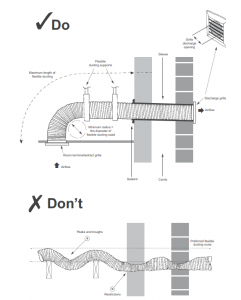
Ducting has been stated as the most common cause of failure of a ventilation system, particularly flexible ducting. Too often, it seems that the installer looks to do things the easy way rather than the correct way. This diagram from the domestic ventilation compliance guidance illustrates the common mistakes with flexible ducting and is also an example of a good installation.
Some of the key considerations with flexible ducting are that it should be kept to a minimum, pulled to 90% of its maximum length with no peaks and troughs. Ducting through walls should always be sleeved to prevent any reductions in the diameter of the ducting.
So, if we are struggling to get this right in new builds where the infrastructure is in place to ensure quality and compliance. What hope do we have when it comes to our existing building stock? Approximately 200,000 new homes are built every year yet the existing housing stock is somewhere in the region of 27m homes. The scale of the problem of poorly ventilated houses is potentially huge.
A Revision of Approved Document F is current being developed and while there is an indication that there is going to be greater consideration for existing buildings, this is absolutely where the focus of this document should be. However, condensation and mould growth problems should never be considered one dimensional.
A surveyor must consider the entire building envelope as well, together with several internal parameters. The heating regime plays an equally important role to ventilation and likewise with moisture production. Understanding dampness in existing buildings is complex and a holistic approach to understanding the issue must be taken. The occupier has to understand the role of ventilation and how it must be used to control and help provide a balanced environment.
In response to improving conditions in existing buildings, the Property Care Association runs a series of workshops looking at condensation, mould and ventilation. The unique Residential Ventilation Masterclass is suitable for anyone involved in the design and installation of retrofitting fans and mechanical ventilation solutions in existing homes.
The association’s Moisture Management Series also includes other training courses, focusing on:
- A Diagnostic Approach to Condensation and Mould.
- Retrofit Insulation Masterclass.
- Evaluating Ventilation in Existing Buildings course.
Contact the training team on 01480 400000 or via email on pca@property-care.org for more information.
James Berry
Technical manager
Property Care Association
+44 (0)1480 400 000
Twitter: PCAPropertyCare
LinkedIn: Property-care-association


